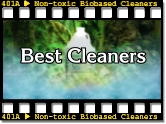
|
|
OVERVIEW
OF INDOOR AIR QUALITY ISSUES
–
What We Don’t Know but Should Know
about the Air We Breathe –
Table of Contents
|

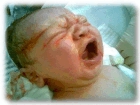 From
our first breath until our last – and all those wonderful breaths
in between, we probably take the air we breathe more for granted than
any other physical aspect of our existences. But should we? Are there
things in the air we breathe that could actually make us sick or harm
us? If so, how much is safe, and how much is too much? Are we doomed
to have to live (or die) with it? Or is there actually something we
can do about it – hopefully before it is too late? From
our first breath until our last – and all those wonderful breaths
in between, we probably take the air we breathe more for granted than
any other physical aspect of our existences. But should we? Are there
things in the air we breathe that could actually make us sick or harm
us? If so, how much is safe, and how much is too much? Are we doomed
to have to live (or die) with it? Or is there actually something we
can do about it – hopefully before it is too late? |
On
the next few pages, you will discover . . .

Every time we take a breath, the supposition is that what
we are breathing is pure, clean air in the exact balanced formulation
we were created to use. But the only time most of us bother to question
that assumption is when we see large amounts of pollution pouring
into the air. Or it may be when something we smell is particularly
unpleasant (soiled diapers, a dead animal, etc.,) or so badly fouled
that it irritates the breathing apparatus in some way or causes us
to choke . . . . more

The
problem is worse than we realize.
1. In
1930, 80% of Americans lived on farms and spent the majority of their
time outdoors. Asthma, and a host of other respiratory ailments, were
relatively uncommon.
2. 50
years ago, the primary cause for health issues from air pollution was
polluted OUTDOOR air.

C. What
Do We Need to Know?
Sorting
out the info and charting a course to follow.
 With
hundreds of products on the market and with all sorts of acronyms,
initials, trade specific terms, and trade names with which to become
familiar, how does one know which equipment to acquire or whose services
to engage? With
hundreds of products on the market and with all sorts of acronyms,
initials, trade specific terms, and trade names with which to become
familiar, how does one know which equipment to acquire or whose services
to engage?
Do
we know for certain what issues need addressing? Do we have to do
anything?
If
we do something, are we sure that what we are doing will work with
the problems we have? . . . more
D. What
are We Breathing?
Unwelcome
guests we receive every time we breathe.
 Here
is a quick look at what it is that we are breathing and the areas
for consideration when contemplating any type of air purification
service or equipment.
. . . more
Here
is a quick look at what it is that we are breathing and the areas
for consideration when contemplating any type of air purification
service or equipment.
. . . more
Airborne
pieces of a lot of stuff we should not be breathing.

Anything floating in or wafted about
in the air small enough to enter our breathing apparatus comes under
this broad category. Generally speaking, most of the particles are
too small to be seen by the unaided eye. Some, however, can be detected
if they are in sufficient quantity and/or under direct illumination
to make them visible.
Particulates include, but are not necessarily limited to . . . more
The
body’s “hit list” of alien invaders.
 . . . If our immune systems identify certain particulates as health threats,
those particles are moved from a "list" the body keeps of irritants
to a "list" of allergens
- things which trigger an allergic response
whether mild or severe. With an allergic response, the body goes on
a kind of "red alert", causing things to happen in order to raise
a defence against the intruders. . . . more
. . . If our immune systems identify certain particulates as health threats,
those particles are moved from a "list" the body keeps of irritants
to a "list" of allergens
- things which trigger an allergic response
whether mild or severe. With an allergic response, the body goes on
a kind of "red alert", causing things to happen in order to raise
a defence against the intruders. . . . more
The
bacteria, viruses, and germs which reproduce in the human body and try
to stage a takeover.
. . . One of the greatest potential risks posed
by particulates goes beyond the offensive materials themselves.
It has to do with the company they keep, or, literally, the microscopic
“guests” they bring with them whenever they are inhaled
— the pathogens. beyond the offensive materials themselves.
It has to do with the company they keep, or, literally, the microscopic
“guests” they bring with them whenever they are inhaled
— the pathogens.
Pathogens,
as a class, are the bacteria, viruses, and germs which reproduce in
the human body and try to stage a takeover. . . . more
Things
have odors for a reason, but why?
Can the problem be corrected rather than merely masked or covered up?
 Things
stink/smell/have an aroma for a reason. Whether it is pleasant, like
the fragrance of a rose, or unpleasant, like vomit or fecal material,
everything which gives off an odor is emitting tiny microscopic pieces
of itself into the air. Those tiny pieces - in incredibly small amounts
- are caught in the nasal passages where their DNA is read by the
olfactory nerves and checked in the brain against a memory bank of
some 10,000 substances to determine what the appropriate response
should be. . . . more Things
stink/smell/have an aroma for a reason. Whether it is pleasant, like
the fragrance of a rose, or unpleasant, like vomit or fecal material,
everything which gives off an odor is emitting tiny microscopic pieces
of itself into the air. Those tiny pieces - in incredibly small amounts
- are caught in the nasal passages where their DNA is read by the
olfactory nerves and checked in the brain against a memory bank of
some 10,000 substances to determine what the appropriate response
should be. . . . more
Are
we possibly drowning in a toxic soup?
 If
we can understand something of the mechanics of how odors originate
and spread through air, we can begin to make sense of the concerns
regarding "Volatile Organic Compounds"
or "VOC's" for short. If
we can understand something of the mechanics of how odors originate
and spread through air, we can begin to make sense of the concerns
regarding "Volatile Organic Compounds"
or "VOC's" for short.
VOC's
can originate from natural sources such as rotting
vegetation or animal matter. They may also come from manmade
sources. Of special concern are those derived from some form
of petroleum or petroleum derivative, known in the industry as "petroleum
distillates" or "petrochemicals". . . . more
Is
what we see dangerous?
And is what we don’t see more dangerous than what we do see?
 Mold
plays a major role in the Divine design to keep all of the ecosystems
in balance, being the primary means by which organic material is recycled.
Because death can occur to any organism at anytime or any place, mold
must be everywhere present and ready to do its intended job of "digesting"
dead material (mostly cellulose, once the moisture is extracted).
Consequently, mold spores - mold's versions of seeds that are so tiny
(less than 4 microns) that as many as 200,000 or so can fit on the
head of a pin - are designed to circulate in some quantity anywhere
the wind blows, including our homes and businesses. . . . more Mold
plays a major role in the Divine design to keep all of the ecosystems
in balance, being the primary means by which organic material is recycled.
Because death can occur to any organism at anytime or any place, mold
must be everywhere present and ready to do its intended job of "digesting"
dead material (mostly cellulose, once the moisture is extracted).
Consequently, mold spores - mold's versions of seeds that are so tiny
(less than 4 microns) that as many as 200,000 or so can fit on the
head of a pin - are designed to circulate in some quantity anywhere
the wind blows, including our homes and businesses. . . . more


Are the technologies pretty much equal, or is their a large disparity among them?
Regardless
of the hundreds of brands and models, there are really only two types
of technologies. What are they and how well does each work? . . . more
The
pollution finds the solution (or so we hope!)
 Passive technology always
employs some form of filtration and
always requires that contaminates find their
way to the filtering device.
A
filter is to the airborne contaminate what the spider's web is to
the insect. No matter how big or how little, regardless
of the size or design, a germ or bug may fly freely about the air
space unless or until it is caught in the trap of the filter fibers
or the web. If it is small enough to slip through the fibers or strong
enough to wriggle loose, it is free to fly about again. . . . more Passive technology always
employs some form of filtration and
always requires that contaminates find their
way to the filtering device.
A
filter is to the airborne contaminate what the spider's web is to
the insect. No matter how big or how little, regardless
of the size or design, a germ or bug may fly freely about the air
space unless or until it is caught in the trap of the filter fibers
or the web. If it is small enough to slip through the fibers or strong
enough to wriggle loose, it is free to fly about again. . . . more
The
solution finds the polution – even where it is hiding!
 As designed for nature, there is virtually no such thing as "passive"
air purification.
While the natural processes for purifying water are primarily passive,
outdoor air is purified by processes which are expressly
active. Sunlight and lightning
and the effects of the wind rushing through the trees (among others)
give us our purified breathable air. The ability to do indoors
what was designed for the outdoors lies at the heart of active
(or pro-active) technology which does not wait for contaminates
to find a filter. . . . more As designed for nature, there is virtually no such thing as "passive"
air purification.
While the natural processes for purifying water are primarily passive,
outdoor air is purified by processes which are expressly
active. Sunlight and lightning
and the effects of the wind rushing through the trees (among others)
give us our purified breathable air. The ability to do indoors
what was designed for the outdoors lies at the heart of active
(or pro-active) technology which does not wait for contaminates
to find a filter. . . . more
 Stage one is actually
a combination of two steps. Two separate ion generators put out large
volumes of both positive and negative ions and introduce them into the
entire environmental space with very little noise. These opposingly
charged ions penetrate through walls, attic spaces, and rooms throughout
the building, causing air-borne particulates to flocculate
or clump together, rendering them too heavy to remain air-borne. . . . more Stage one is actually
a combination of two steps. Two separate ion generators put out large
volumes of both positive and negative ions and introduce them into the
entire environmental space with very little noise. These opposingly
charged ions penetrate through walls, attic spaces, and rooms throughout
the building, causing air-borne particulates to flocculate
or clump together, rendering them too heavy to remain air-borne. . . . more
Combining high intensity UVX light with a specially developed rare
metal hydrophilic coating on an engineered matrix, Radiant
Catalytic Ionization™
(RCI™) reduces airborne contaminants, and odors while
creating super oxide ions and hydro-peroxides. While active, these
oxidizers also have the potential of infiltrating behind
wall cavities, and wherever they go they strip the very hardy
shells off of mold spores, fungi, and numerous other pathogens and
contaminants, killing them outright or rendering them very susceptible
to destruction. . . . more odors while
creating super oxide ions and hydro-peroxides. While active, these
oxidizers also have the potential of infiltrating behind
wall cavities, and wherever they go they strip the very hardy
shells off of mold spores, fungi, and numerous other pathogens and
contaminants, killing them outright or rendering them very susceptible
to destruction. . . . more
 In stage three,
additional technology generates a tunable level of naturally
occurring penetrating oxidation gases which attack the nuclei of the
now exposed cells, either fully killing the pathogenic cell, or, as
in the case of mold spores, affecting the RNA and the DNA of the spores
so that they cannot reproduce. . . . more In stage three,
additional technology generates a tunable level of naturally
occurring penetrating oxidation gases which attack the nuclei of the
now exposed cells, either fully killing the pathogenic cell, or, as
in the case of mold spores, affecting the RNA and the DNA of the spores
so that they cannot reproduce. . . . more
As
with the ions, the generated oxidizing plasmas are so efficient that
they penetrate to wherever the germs are hiding and render them harmless.
This patented triple combination of pro-active technologies is available
exclusively under the trade name of "RCI"TM,
so named for "Radiant
Catalytic
Ionization",
also trademarked. RCITM has been shown in university
studies to have a kill rate as high as six log (99.9999%) of surface
laden pathogens anywhere in the air space. . . . more and render them harmless.
This patented triple combination of pro-active technologies is available
exclusively under the trade name of "RCI"TM,
so named for "Radiant
Catalytic
Ionization",
also trademarked. RCITM has been shown in university
studies to have a kill rate as high as six log (99.9999%) of surface
laden pathogens anywhere in the air space. . . . more
 Where
is Clara Peller when you need her?
But it gets even funnier. We have the Best
Available Today's Technology (“BATT”)
which efficiently removes the dirt (particulates) from the air so
that there is nothing in the air to capture on which to measure
the health and vitality of germs. Yesterday's science says, “Since
we can't find any dirt to check for germs (it’s too CLEAN),
we cannot certify how pure (germ free) your air is.” . . . more Where
is Clara Peller when you need her?
But it gets even funnier. We have the Best
Available Today's Technology (“BATT”)
which efficiently removes the dirt (particulates) from the air so
that there is nothing in the air to capture on which to measure
the health and vitality of germs. Yesterday's science says, “Since
we can't find any dirt to check for germs (it’s too CLEAN),
we cannot certify how pure (germ free) your air is.” . . . more
Anybody
can see that it’s clean except the career bureaucrats.
Reason would dictate that in the absence
of particulates, any viable pathogens are left without a transport
mechanism by which to enter our private air spaces. That
has to be a positive factor in the overall indoor air quality.
But
is it enough? Knowing that we can't test the “purity”
of the air by means of the old methods and definitions, we set out
to test the effectiveness of the technology itself. . . . more
Hint:
One place they are not is “Blowin’ in the Wind”.
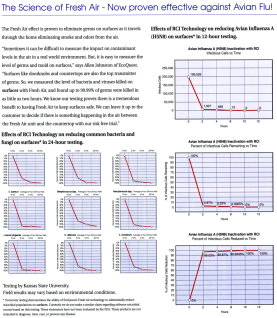 . . . We went after some pretty infamous bacteria -- fellas
like Staphylococcus aureus, MRSA (the antibiotic resistant
strain of Staphylococcus aureus that is wreaking havoc in
our hospitals), E. coli, Bacillus spp., streptococcus spp.,
Listeria monocytogenes, Stachybotrys chartarum (black mold),
etc., mean guys with ugly names and bad reputations. Within
surprisingly short periods of time, kill rates on the pathogen
samples were averaging well above 99% . . . more . . . .
. . . We went after some pretty infamous bacteria -- fellas
like Staphylococcus aureus, MRSA (the antibiotic resistant
strain of Staphylococcus aureus that is wreaking havoc in
our hospitals), E. coli, Bacillus spp., streptococcus spp.,
Listeria monocytogenes, Stachybotrys chartarum (black mold),
etc., mean guys with ugly names and bad reputations. Within
surprisingly short periods of time, kill rates on the pathogen
samples were averaging well above 99% . . . more . . . .
In
the war against pathogens, would you like your germs captured and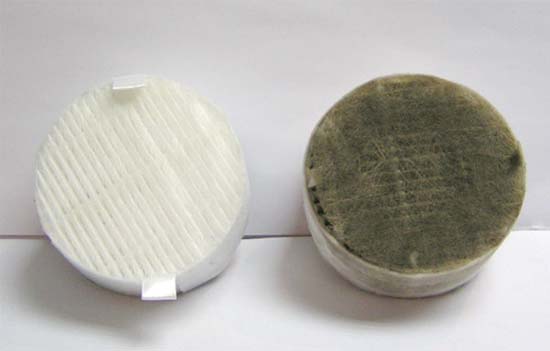 contained or killed graveyard dead?
contained or killed graveyard dead?
In laboratory as well as
practical terms, there is a HUGE difference between a kill
rate of 99 to 100% with RCITM
and the maximum HEPA figures — as respectable as they
seem to be — of 99.97% of filtration
of particles larger than a certain size which happen
to pass through the filtering device. . . . more
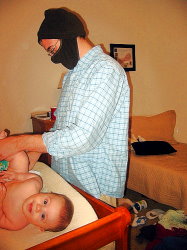 The
same thing that RCITM
does to particulates and germs it does also to smoke, dust,
and sources of odors.
The
same thing that RCITM
does to particulates and germs it does also to smoke, dust,
and sources of odors.
Once
oxidized by RCITM,
an odor source is no longer in decay and is therefore rendered
neutral, harmless, and odor free – without toxic sprays
and ineffective (and possibly hazardous) deodorant cover
ups. Likewise, RCITM
goes to work on the chemical offgassings of VOC's, which
are also neutralized and rendered far more harmless. . . . more

F. What
IAQ issues must be considered and addressed?
 Head
to head comparison of the technologies – very revealing. Head
to head comparison of the technologies – very revealing.
Before
acquiring any type of air purifier or installing any kind of whole
house or whole building system, it might be best to consider what the
expected outcome should be and compare it with the capacities of the
device or system to achieve those goals. . . . more
G. Are
there medical considerations?
 Obligatory
disclaimers and the practical realities of what happens when a sick
body can actually catch its breath. Obligatory
disclaimers and the practical realities of what happens when a sick
body can actually catch its breath.
None
of the items Pro-active Environmental Technologies recommends are currently rated as or to be considered as medical
devices in the legal understanding and use of the term.
Therefore, no medical claims are made for the use or the failure to
use any of the offered equipment. . . . more
H. Are
there legal and other considerations?
What happens if we just ignore the problem or fail to investigate it fully?
 Applications
of these technologies have practical, economical, and legal implications.
Having these systems in place will help insure against mold infestations
so prevalent in the Gulf Coast climate and elsewhere. By all but eliminating
any particulates, the indoor breathing space will not create a burden
on the environs, and housekeeping will be much more easily accomplished
and maintained. . . . more
Applications
of these technologies have practical, economical, and legal implications.
Having these systems in place will help insure against mold infestations
so prevalent in the Gulf Coast climate and elsewhere. By all but eliminating
any particulates, the indoor breathing space will not create a burden
on the environs, and housekeeping will be much more easily accomplished
and maintained. . . . more
I. When
is Timing an Issue?
If
the mold or other air quality problem doesn't seem to be spreading or
getting any worse, do we really have to pay it any attention?
 As
an environmental consideration, the sooner proper air purification equipment
is installed, the less of a build-up of indoor air contaminates will contribute
to the overall health hazards of the occupants. If construction is old,
mold colonies could already be forming in out of sight places while contributing
to the declining air quality. Levels of dangerous toxic substances could
already be reaching critical levels, and the sooner all negative contributors
are neutralized, the better for all (except, perhaps, the lawyers).
As
an environmental consideration, the sooner proper air purification equipment
is installed, the less of a build-up of indoor air contaminates will contribute
to the overall health hazards of the occupants. If construction is old,
mold colonies could already be forming in out of sight places while contributing
to the declining air quality. Levels of dangerous toxic substances could
already be reaching critical levels, and the sooner all negative contributors
are neutralized, the better for all (except, perhaps, the lawyers).
. . . more
|

A. Is there a problem?

Stories
are told of people who have gone without a scrap of food to eat for extraordinary
periods of time -- often over a month or so.
And remarkably, although our bodies are comprised
of some 70% of water, some individuals have gone for close to a week or
even longer without water and have survived - although by then they were
in serious danger.
But almost without exception, one to two minutes is about all
we can go without breathing without experiencing extreme discomfort. And
usually, without air for four to six minutes, we lose consciousness and
bodily functions begin shutting down. Beyond six minutes, it is almost
a given that there will be irreparable brain damage and probable death.
So it is ironic that, of the three - food, water,
and air - the one most necessary is the one we mos t likely take for
granted. Every time we take a breath, the supposition is that what
we are breathing is pure, clean air in the exact balanced formulation
we were created to use. But the only time most of us bother to question
that assumption is when we see large amounts of pollution pouring
into the air. Or it may be when something we smell is particularly
unpleasant (soiled diapers, a dead animal, etc.,) or so badly fouled
that it irritates the breathing apparatus in some way or causes us
to choke -- like the smell of mold in a closed room or the presence
of heavy smoke or smog. t likely take for
granted. Every time we take a breath, the supposition is that what
we are breathing is pure, clean air in the exact balanced formulation
we were created to use. But the only time most of us bother to question
that assumption is when we see large amounts of pollution pouring
into the air. Or it may be when something we smell is particularly
unpleasant (soiled diapers, a dead animal, etc.,) or so badly fouled
that it irritates the breathing apparatus in some way or causes us
to choke -- like the smell of mold in a closed room or the presence
of heavy smoke or smog.
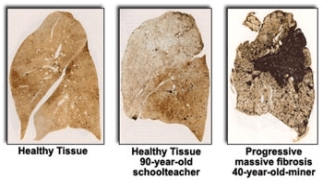 The
fact is, that with every breath we take, we are also taking into our
lungs and bodies any number of other things, including gasses (many of
which we cannot smell so that we are unaware of their presence or
harm), odors (which are molecular samples of the things causing the
smell), fats, oils, and grease, and varying amounts of tiny pieces of
solid materials we often refer to as "dust" - which may be comprised of
all manner of things from metallic, to mineral, to chemical, to organic. The
fact is, that with every breath we take, we are also taking into our
lungs and bodies any number of other things, including gasses (many of
which we cannot smell so that we are unaware of their presence or
harm), odors (which are molecular samples of the things causing the
smell), fats, oils, and grease, and varying amounts of tiny pieces of
solid materials we often refer to as "dust" - which may be comprised of
all manner of things from metallic, to mineral, to chemical, to organic.
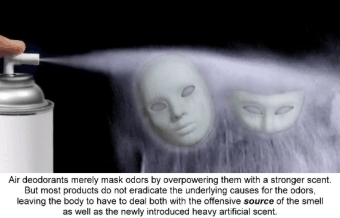 While
Americans annually spend some $3 billion to cover up smells they find
offensive, reality dictates that serious air purification must look
beyond room fresheners and scented candles and get to the source of
our indoor air quality concerns. While
Americans annually spend some $3 billion to cover up smells they find
offensive, reality dictates that serious air purification must look
beyond room fresheners and scented candles and get to the source of
our indoor air quality concerns.
Is
there a problem? Those charged with building and maintaining our
buildings think so. The EPA thinks so. Those who have
gotten sick in our buildings think so. Major attorney firms think
so. More and more doctors are beginning to think so. And after
reading the material on these pages you, too, may understand what has
so many people concerned -- and unhealthy. And you will also be
introduced to some new and exciting technologies which can fix what's
wrong with our indoor environment if it is sick and pro-actively
maintain it in a safe, clean, fresh way like never before!

|

Not
to scare you, but the problem is worse than you
realize.
|
|
1. |
In
1930, 80% of Americans lived on farms and spent
the majority of their time outdoors. Asthma, and
a host of other respiratory ailments, were relatively
uncommon. |
|
|
2. |
50
years ago, the primary cause for health issues
from air pollution was polluted OUTDOOR air.
|
|
3. |
|
|
|
4.
5. |
Our
current problem began with the oil embargo of
the 1970's.
The
response of the market place
--
- Reduced
maximum speed limits to 55 mph;
Adjusted thermostats to 65o F in
the winter and 78o F in the summer;
- Passed
stringent building codes demanding more energy
efficient homes; and
- Substantially
increased the number and types of synthetic
building materials which both raised the level
of VOC's and
lowered the amount of air infiltration.
|
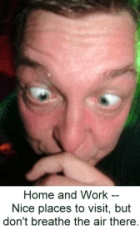 |
6. |
The
result in the market place
--
- Sick
Building Syndrome emerged in the 1980's.
It is estimated that at least ONE
in THREE buildings is now SICK.
- Additionally,
ONE in TWO homes is thought to have
a MOLD PROBLEM, but the occupants
may not be aware of it. Which
one do you work/live in?
- 15
million+ Americans now have asthma,
(up 80%) and the number is climbing.
- 28
million+ Americans suffer from hay
fever and allergies, and THAT number
is climbing.
- Air
pollution contributes to lung disease,
including respiratory tract infections,
asthma, and lung
cancer.
|
|
7. |
By
1980, at least 80% of Americans have been living
in urban environments. Since 1980, incidence of
ASTHMA is UP 80%. Coincidence? |
|
8. |
We
Americans spend 90% - 95% of our time INDOORS.
Over the average lifetime, that is 65 YEARS
of breathing INDOOR air.
|
|
|
9. |
U.S.
EPA studies have shown that the levels of many
airborne pollutants may be 25 to 100 times
higher indoors than outdoors. Is there
a cause/effect thing here? |
|
10. |
80%-90%
of most people’s exposure to pesticides
occurs indoors. |
 |
11. |
Sadly,
we have come to expect industrial and mining workers
to get sick because of the nature of their work
exposure, yet 35 - 60 million of America’s
NON-INDUSTRIAL workers are ILL per WEEK.
Do
we all eat at the same restaurant?
Or do we all breathe the same kind of air?
|
|
12. |
50%
of ALL ILLNESSES are either caused or exacerbated
by poor IAQ.
Take
a breath and wonder why medical insurance
is so high.
|
|
13. |
The
EPA, the United States House of Representatives,
and the World Health Organization rank INDOOR
air pollution as THE Number One environmental
health problem. |
|
|
14. |
The
AIA (American Institute of Architects) rates Indoor
Air Quality issues as the number one issue to
be addressed by architects, engineers,
and contractors at least until the year 2010. |
|
|
|
|
|
15. |
Productivity
losses from Sick Building Syndrome symptoms
are estimated to be around 2 percent among office
workers, costing an estimated $50 billion
annually. |
|
|
|
|
|
16. |
U.S.
Department of Energy studies suggest that improving
buildings and indoor environments could
reduce health-care costs and sick leave and increase
worker performance, resulting in an estimated
productivity gain of $30 to $150 billion annually. |
|
|
|
|
|
17. |
The
DOE further estimated that the potential decreases
in adverse health effects from improvements
in indoor environments to be 10 to 30 percent
for infectious respiratory disease and allergy
and asthma symptoms and 20 to 50 percent for
Sick Building Syndrome symptoms.
|
|
|
|
|
|
18. |
In
addition, the potential direct increase in office
workers' performance was estimated to range
between 0.5 and 5 percent. For the U.S., the
corresponding annual health-care savings plus
productivity gains are --
- $6
to $19 billion from reduced respiratory
disease;
- $1
to $4 billion from reduced allergies and
asthma;
- $10
to $20 billion from reduced Sick Building
Syndrome symptoms, and
- $12
to $125 billion from direct improvements
in worker performance that are unrelated
to health.
Ever
wonder what happened to that Christmas bonus
you were wishing for?
|
|
19. |
90,000 to 100,000 American patients DIE each year
from nosocomial infections they acquire in HOSPITALS
and HEALTH CARE FACILITIES while under medical
care. Millions more just get sick. Some
face a lifetime of chronic problems and follow
up care. It’s a national disgrace. Where
should they go for treatment? And who should pay
for it? |
|
|
|
|
|
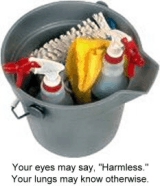 |
20. |
Numerous
studies conducted by the EPA over the last 25
years have shown measurable levels of
over 107 known carcinogens in modern offices and
homes. |
| 21. |
Each
year, over 1000 NEW CHEMICALS are approved to
be used and released into our air. How
long term have been the safety studies? How do
they interact with what is already or soon to
be out there? How many are our bodies supposed
to be able to handle? |
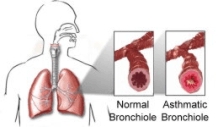 |
22. |
The
shoes you wear outside and with which you walk
inside carry, among other things, FECAL
MATTER, BACTERIA, and MOLD which are deposited
on the flooring, carpeting, furniture, and bedding.
Hey! Let’s all get down on the floor and
play with the kids! |
|
23. |
Portions of that same FECAL MATTER, BACTERIA,
and MOLD are sucked up into the average vacuum
cleaner where they incubate and reproduce.
Any idea what happens the next time the vacuum
is used? |
|
|
24. |
1 ounce of household dust contains about 43,000
dust mites and their FECES. After six months,
it is estimated that 60% of your pillow’s
weight is dust mites and their FECES. Dare you
guess how many millions are in your mattress? |
|
|
25. |
Exposure to dust mites, cat saliva, animal dander,
and mold, is estimated to cause at least 200,000
emergency room visits by asthma patients each
year. Care to join them? |
|
26. |
And, as if these concerns were not enough, we
now face the real threat of airborne biological
weapons. Are we absolutely sure that "the government"
is going to be able to protect us? Is there
something we can and should be doing for ourselves?
Does the name "Katrina" bring to mind
any lessons we should have learned about taking
personal responsibility?
|
|
It seems pretty ironic.
As necessary as breathing is,
it is almost an endangerment to one's health to
do so.
Is anyone paying attention?
Are there any real answers to these out of control
problems?
|

C.
What do we need to know?

Research
into Indoor Air Quality (IAQ) issues can quickly lead
to information overload.
With
hundreds of products on the market and with all
sorts of acronyms, initials, trade specific terms,
and trade names with which to become familiar, how
does one know which equipment to acquire or whose
services to engage?
Do
we know for certain what issues need addressing?
Do we have to do anything?
If
we do something, are we sure that what we are doing
will work with the problems we have?
Are
we approaching the need the best way?
Are
we doing enough to deal with the problems effectively?
Is there, as with drinking water, such a thing as too
much good air or too
pure an air quality?
Cutting
through all of the above can take a lot of time, energy,
and expense when those commodities may not be in abundant
supply.
Fortunately, a brief understanding of the problems and
the science behind the solutions can help us reach a
satisfactory understanding and set us on an active path
of correction and prevention.
D.
What are we breathing?
Here
is a quick look at what it is that we are breathing and
the areas for consideration when contemplating any type
of air purification service or equipment.
|

1.
Particulates.

"A
magnified view of aerosol particles collected
in the industrial city of Port Talbot,
England. Many of the particles measure
roughly 2.5 microns across, small enough
to easily enter and damage human lungs."
(Courtesy of NASA/MRC Institute for Environment
and Health)
Anything
floating in or wafted about in the
air small enough to enter our breathing
apparatus comes under this broad category.
Generally speaking, most of the particles
are too small to be seen by the unaided
eye. Some, however, can be detected
if they are in sufficient quantity
and/or under direct illumination to
make them visible.
Particulates include, but are not necessarily
limited to,
|
|

|
airborne
dirt;
ash and combustion products
– whether from tobacco products, forest
fires, commercial and industrial furnaces and
smokestacks, incinerators of all kinds, or volcanic
eruptions;
dander – dead skin cells
from animals and people; (The average adult
sheds about 80,000 skin cells an hour!)
dust, including powdered stone
and other minerals such as gypsum (drywall),
powdered talc, other minerals, and coal; |
|
dust
mites and other microscopic parasites
and their feces, etc., (We are definitely not
alone! These are the critters who feed on all
those skin cells we are forever flaking off.)
fibers – can be a number
of different types from a diversity of origins,
as in mineral fibers (such as asbestos and fiberglass);
natural textile fibers (as in cotton, linen,
silk, wool, etc.) synthetic textile fibers (carpet
and all manner of other indoor sources); and
other organic fibers, such as paper and cardboard;
fingernail filings;
food crumbs; (Alright, they
are for eating, but over a life time more get
into your body through your breathing passages
than you would ever care to imagine.)
feathers and feather pieces;
glass particles (other than
fiberglass);
glue;
graphite, carbon, and other
finely ground powders, etc.;
hair, animal and human –
includes fur;
insect fragments (actual pieces
of body parts, feces, etc.;
metal shavings and dust (from
manufacturing and milling activities or any
friction causing motion involving metallic components;
mold and other spores, enzymes,
and colony particles;
oil soot;
paint chips;
plant parts; These can be any
portion of one or more parts of any type of
vegetable matter. It can also include grain
dust and flour from grain storage and milling.
pollen (all sources); (Each
plant’s pollen looks different from
others’,
but
a common shared feature is their cockleburr-like
appearance, a characteristic not lost on the
sensitive linings of the brachia and lungs.)
polymer foam particles;
resin powders and dusts;
salt and sugar crystals;
sand and soil; and
wood shavings, to mention a
few, all of which increase the respiratory burden
just by their very presence. |
|

Particulates
also include the components known by the
acronym "F.O.G." for "Fats, Oils, and Grease".
Spend
much time around a kitchen or a machine
shop, and you are dealing with a otentially
serious buildup of some mighty nasty materials.
Picture coating the linings of your lungs
with dirt and butter or axle grease, and
you will understand why breathing dust and
FOG makes us cough or sneeze (natural responses
designed to expel particulates).
Fortunately,
as sensitive and vulnerable as our airways
and lungs are, they were designed to be
able to fend off many of these particulate
contaminates and remarkably recover from
unwelcome encounters with them — all
other things being equal.
However,
for reasons set forth more fully elsewhere,
our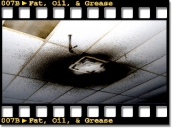 exposures to a growing number of these
particulates are becoming more frequent
and cumulative, and with less than ideal
recovery conditions, less than optimum
nutrition, and a general lack of good,
breathable air, we are increasingly falling
victim to their ravages.
exposures to a growing number of these
particulates are becoming more frequent
and cumulative, and with less than ideal
recovery conditions, less than optimum
nutrition, and a general lack of good,
breathable air, we are increasingly falling
victim to their ravages.
One
of the ways we are being affected is by
the body’s “blacklisting”
certain of the breathables and causing
our bodies to respond in a negative manner
whenever there is an exposure to them.
These are called allergens, which we will
review next.
But
we should remember, as well, that there
is a potentially greater -- though not
so evident --risk posed by particulates
which goes beyond the offensive materials
themselves. Along with being irritating
and harmful on their own, breathable
particles are the vehicles on which germs,
viruses, and other pathogens ride into
our airways and make us sick.
The greater the volume of particulates
in the air we are breathing, the greater
the chances that we will be infected and
made ill.

There
are two parts to breathing:
inhalation
- where life sustaining oxygen is brought
into the body through our airways and
lungs by breathing in, and
exhalation
- where the gaseous wastes carried in
our blood stream and sent to our lungs
for expulsion are expelled by breathing
out. Sometimes, the air we breathe in
contains things which do more than just
clog the sensitive tissues designed
to handle the exchange of good and bad
air.
Beyond
just making it difficult to breathe, any
particles not filtered out by the hairs
in our nostrils will have to be dealt with
by our bodies. If our immune systems identify
certain particulates as health threats,
those particles are moved from a "list"
the body keeps of irritants
to
a "list" of allergens
-
things which trigger an allergic response
whether mild or severe. With an allergic
response, the body goes on a kind of "red
alert", causing things to happen in order
to raise a defence against the intruders.
 Items
with specific DNA signatures such as mold
spores, mold enzymes,
pollen, animal
dander, animal fur
or hair, dust
mites, dust mite feces,
bacteria on the dust mite
feces, and bits of rodent or other
animal feces are just a few of
these. Like coughs and sneezes, the typical
symptoms of "hay fever" (swollen, runny
eyes, sore throat, runny nose, swollen sinus
membranes, etc.), asthma attacks, and even
grand mol seizures are all part of the body's
way of trying to rid itself of the offending
material before it makes us really sick.
Or worse.
There
are at least three issues here.
 The
most obvious one is the body's reaction
to a specific irritant whose presence
has escalated the immunal response to that
of an allergic reaction. The
most obvious one is the body's reaction
to a specific irritant whose presence
has escalated the immunal response to that
of an allergic reaction.
The second issue has to do with the phenomena
medical science is beginning to track having
to do with the effect of continual
allergen loads on our bodies. It
is found that over time and repeated exposure,
even healthy people can develop serious
allergies, and those with serious allergies
can become really ill. The
third issue is one that has gotten little
press or research but may be far more serious
than the other two. It has to do with the
cross or cross over reactions when
MULTIPLE allergens are present
and the varied negative reactions begin
to complicate matters beyond what science
can track and the body can handle.
In
all three instances, prudence would dictate
that prevention
will prove more effective than
treatment.
3.
Pathogens.

As
has been pointed out, one of the greatest
potential risks posed by particulates
goes beyond the offensive materials
themselves. It has to do with the company
they keep, or, literally, the microscopic
“guests” they bring with
them whenever they are inhaled —
the
pathogens.
|
|
Pathogens,
as a class, are the alien bacteria, viruses,
and germs which, upon entering the host body,
reproduce and try to stage a takeover.
Pathogens
can be deadly or dangerous like
the Spanish flu, avian
("bird") flu, SARS,
Legionnaires' Disease, e
coli, e bola, Listeria,
Norwalk virus, and the like (with
a whole host of others yet to be identified),
or just nuisance things like the common cold
or the stuff that happens during a sneeze.
|
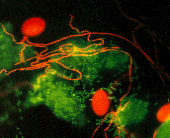
Microscopic
bacteria |
|
 It
was millennia before civilization relearned
what the ancients knew about the effects
of washing in running water to help reduce
infection. However, even when proper hygiene
is practiced, we still get sick from germs
which make their ways into our bodies. How
is that possible? If we are not ingesting
them through our mouths or they are not
insinuating themselves into our systems
by bodily contact, how is it we are still
getting sick? It
was millennia before civilization relearned
what the ancients knew about the effects
of washing in running water to help reduce
infection. However, even when proper hygiene
is practiced, we still get sick from germs
which make their ways into our bodies. How
is that possible? If we are not ingesting
them through our mouths or they are not
insinuating themselves into our systems
by bodily contact, how is it we are still
getting sick?
We
have again lately come to the understanding
known from Biblical times that germs are
spread as well through the air and enter
our bodies by way of the air we breathe.
The mechanism of how this happens is not
what most people think.
Strangely (and fortunately) enough, pathogens
do not typically have wings or the ability
to travel through the air on their own. Without
their own means of air travel, they must opportunistically
hitch a ride on something else which either
has "wings" or at least enough substance to
it that it can swirl, mostly unseen, through
the air and become part of the air we breathe.
Hence, the pathogen/particulate
connection. |
For
a germ or virus to navigate from one place to
another over distances is usually dependent
upon the presence of some type of particulate
matter, including, but certainly not limited
to, the 80 thousand skin cells each human typically
sloughs off in an hour. As these micro particles
are wafted about on the air, they become the
"air force" upon which the invading pathogens
are carried and by which they make their way
into the lungs of a building's occupants. Common
sense would tell us that the fewer particles
available in the breathable air, the less likely
for infections to spread within an indoor environment.
[NOTE: Could
this put us on track to control the spread of
infections such as TB, SARS, Hepatitis "A".
the Avian flu, and other potential pandemics?
Keep reading!] |

Be
sure to check out below
the American-based technology that beat SARS!
|
| But
even if particulates were reduced
or eliminated (which would leave pathogens
without a way to fly into our lungs), surface
laden pathogens would continue to pose a
menace to health if left to grow where they
rest. |
|
Along with targeting particulates, an effective
IAQ configuration must have a way of reducing
or virtually eliminating pathogens. At the
very least, it should keep them from reproducing.
|
Remembering
that our bodies - through our immune systems
- have been designed to handle pathogenic
invaders, we recognize that most pathogens
in small numbers do not pose a major risk.
It is the ability of any of the pathogens
to survive and reproduce which most
often creates the problem which overwhelms
us and makes us sick.
Outdoors,
pathogens are kept in check, again by design,
by the presence of UV light from the sun and
other naturally occurring oxidizers circulating
in the fresh air. But in the sealed
boxes in which we live, pathogens are free
to reproduce and, in the presence of antibiotics,
to mutate.
|

Top of IAQ Overview -- Table of Contents --^
<<-- Previous Chapter: IAQ Overview -- What Do We Need to Know?
Beginning
of this Chapter: IAQ Overview -- What Are We Breathing? --^
Next Chapter: IAQ Overview -- Which Technology Works the Best? -->

4.
Odors.
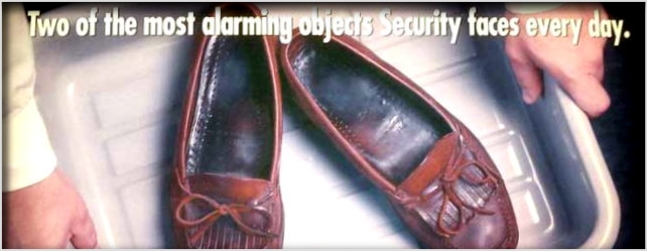
Things
stink/smell/have an aroma for a reason.
Whether it is pleasant, like the fragrance
of a rose, or unpleasant, like vomit
or fecal material, everything which
gives off an odor is emitting tiny
microscopic pieces of itself into
the air. Those tiny pieces - in incredibly
small amounts - are caught in the
nasal passages where their DNA is
read by the olfactory nerves and checked
in the brain against a memory bank
of some 10,000 substances to determine
what the appropriate response should
be. It is not by accident that substances
which have a universally recognizable
foul odor are known to be harmful
to us. Their telltale odors are a
fairly sure sign for us to avoid them.
This
emission of molecules by a substance
is similar, by illustration, to the
way that humans lose skin
cells. We do not lose our entire epidermis,
at least not all at once, but shed
instead those dead cells closest to
the surface of our skins. In like
manner, all things aromatic "slough
off" or emit microscopic pieces of
themselves throughout most, if not
all, of their existences.
The
rates at which this emission occurs
from a substance is dependent upon
the ability or lack of ability of
the mass of the matter to retain those
molecules furthest from the center
of the mass and closest to  the
surface - where they tend to break
free of the chemical bonds which hold
them together and take flight into
the surrounding air. This phenomenon
is called "off-gassing", and the measure
of the rate at which
it occurs is the measure of its "volatility".
Depending upon the nature of the substance
itself, the product of the off-gassing
will be either benign or toxic. (See
"VOC's" next.) the
surface - where they tend to break
free of the chemical bonds which hold
them together and take flight into
the surrounding air. This phenomenon
is called "off-gassing", and the measure
of the rate at which
it occurs is the measure of its "volatility".
Depending upon the nature of the substance
itself, the product of the off-gassing
will be either benign or toxic. (See
"VOC's" next.)
A
further consideration is the fact
that a substance en masse
or as a solid may not pose a health
risk, yet the emitted molecules may,
because as a solid substance the product
is not inhaled, but the gases or emitted
molecules are.
Our
response to offensive odors in our
homes and workplaces is usually to
cover them up by overwhelming our
smell mechanisms with fragrances we
prefer over those we do not. We use
potpourri,
scented
candles,
air
sprays,
carpet
and upholstery sprays,
closet
hangers,
outlet
puffers,
pet
sprays,
and a rising proliferation of room
deodorizers
and air
fresheners
of varying sophistication -
to the tune of upwards of $3 billion
annually.
Consider
also that one can hardly take a bath
or shower, shampoo the hair, wash
the hands, wash the dishes,
flush the toilets, clean house, or
process the laundry without adding
still
more of these cover
up perfumes. Unfortunately, tricking
our noses into thinking that everything
smells pleasant does not do away with
the fact that the sources for the
unwanted odors remain active and productive
and continue to cause harm to our
bodies when they can. And
the rising use of fragrance enhanced
products is now causing people to
develop perfume sensitivities
and allergies for which many
are seeking medical attention.
|

5.
Chemicals/Smoke/VOC's.
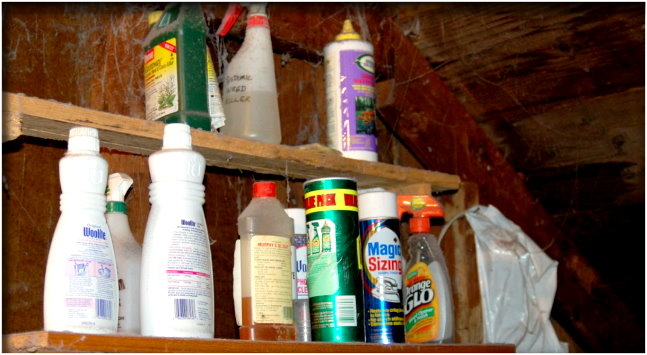

If
we can understand something of the mechanics
of how odors originate and spread through
air, we can begin to make sense of the
concerns regarding "Volatile
Organic Compounds"
or "VOC's" for short.
VOC's
can originate from natural sources
such as rotting vegetation or animal matter.
They may also come from manmade
sources. Of special concern are
those derived from some form of petroleum
or petroleum derivative, known in the
industry as "petroleum distillates"
or "petrochemicals".
|
Regardless
of source, VOC's may range from mildly
noxious to lethal, depending both on
the type of material and the amount of the exposure.
Some naturally occurring VOC's, such as radon
or methane gas, can be quite
debilitating or dangerous.
And
reading the Material Safety Data Sheets
("MSDS") on many fairly
common household products should cause a great
deal of caution or alarm. |
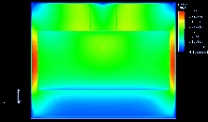
Spectral
analysis of the VOC emissions from building
materials in a newly finished room. |
|
VOC's
may or not have a discernable odor
to alert one to their presence and possible
danger. For instance, natural gas
is naturally odorless yet terribly deadly.
Government regulations require that a foul
smelling substance is added to the gas to
let us know when gas may be present and warn
of its dangers. Other VOC's do give off warning
smells, initially, but with the proliferation
of so many artificial substances, we
have overwhelmed our discerning sensitivities
and gotten accustomed to dealing with myriads
of potentially harmful odors.
One
way we have done so is by means of the surface
and room odorants we so quickly and thoughtlessly
use. Another way is by means of a natural
response whereby, after
prolonged exposure, our olfactory systems
often cease to recognize the presence of constant
odors.
In neither case does it mean that the VOC's
have gone away or that they no longer pose
a threat. It just means that we do not give
them the attention they deserve.
|
|
With
today's building materials and products, it
is almost like having a chemical plant right
in your own living room!
|
What
are typically branded as V.O.C.'s and of the
most concern are usually found indoors in the
off gassings given by synthetic carpet,
paints, finishes,
furniture, circuit
boards, household and commercial
cleaning products, insecticides,
synthetic surfaces, particle
wood products, and thousands of other
common household and commercial items. They
are of special concern in indoor environments
where the same air is constantly re-circulated
and the concentrations of the emitted
gases can build. New construction
is especially notorious for bringing together
numerous products and substances known to be
at their most volatile (and dangerous) state,
though the emission of micro particles will
continue almost indefinitely throughout the
lifetime of the product. |
Likewise, new cars
are known for their characteristic "new
car smell" generated by the combination
of VOC's from the numerous synthesized
materials they contain. While that
smell is typically linked to the pleasant
experience of acquiring new transportation,
its presence may not be altogether benign.
|
| Further
complications arise when gases of certain
chemicals which singly may have little or
no toxic effect combine with other chemical
gases and create new compounds which are toxic
to some degree, whether
mild or severe. Multiple combinations of these
new gaseous compounds (referred to in the
IAQ community as "toxic soups") can have a
combined net effect which is very hazardous
in a closed indoor environment. It is no doubt
one of the reasons that the US EPA has stated
that we are five times more likely to get
cancer from our indoor environments than by
any of the pollution exposures we would get
out of doors. |

No IAQ plan is complete which does not address
the reduction, neutralization, or elimination
of VOC's. |
Next Chapter: IAQ Overview -- Which Technology Works the Best? -->

6.
Mold.
 |
Mold
plays a major role in the Divine design
to keep all of the ecosystems
in balance, being the primary
means by which organic material is recycled.
Because death can occur to any organism
at anytime or any place, mold
must be everywhere present and ready
to do its intended job of "digesting"
dead material (mostly cellulose,
once the moisture is extracted). Consequently,
mold spores - mold's versions of seeds
that are so tiny (less than 4 microns)
that as many as 200,000 or so can fit
on the head of a pin - are designed
to circulate in some quantity anywhere
the wind blows, including our homes
and businesses.
Mold spores can also easily attach to
our shoes and clothing, the fur and
coats of animals, and may even be carried
about on the bodies or body parts of
insects. In short, anything
entering our indoor living space is
probably accompanied by mold spores.
Mold
species are created to be extremely
opportunistic, hardy, prolific, and
territorial. Consequently, mold
is in a position to begin its work
on organic material anywhere at
any time that conditions favor colonization
-- regardless of the age or expense
of the site.
|
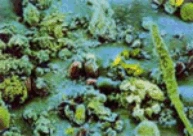
Hardly visible to the unaided eye unless in
major concentrations, this is more like how
our immune systems view mold and mold spores. |
Since the oil shortages of the early to mid
1970's, in an effort to conserve energy, we
stopped building our structures in ways that
allow for the free circulation and exchange
of fresh air into our living spaces, utilizing
instead building methods that do not allow our
structures to breathe or release moisture buildup.
As a consequence, we now live in conditions
which increasingly favor mold growth better
indoors than are found outdoors. Annual
estimates of structural damages attributed to
mold range in the multiple billions, and costs
are climbing each year with insurance companies
assuming less and less of the risk. |
Of
the 100,000 mold species which have been catalogued
(with perhaps another 200 - 300k we have yet
to discover) - there are probably less than
100 (or perhaps no more than around fifty)
that pose any kind of health hazard to humans.
The bad news is that the top four
or five of those mold species which do pose
a health risk are the very ones which take
up residence indoors.
There
is presently no way of predicting ahead of
time who will or will not be most affected
by mold or at what level.
Each individual is different, and what one
can tolerate may well be harmful or even fatal
to another. The assumption is that the weaker
and more infirm will suffer the most, but
mold has been known to take down healthy
adults in their primes.
What
baffles many patients and their doctors is
that there are hosts ofmold-related
maladies and
illnesses for which patients are being treated,
whether as inflammations,
allergies, or infections,
where the root connection to the mold infestation
is not made. Allergic reactions (often referred
to as hay fever) are most common following
mold exposure. Typical symptoms that
mold-exposed people report (alone or in combination)
include, among others, a plethora of chronic
and debilitating problems, ranging from mild
irritations to long-term life-threatening
or ending conditions such as - |
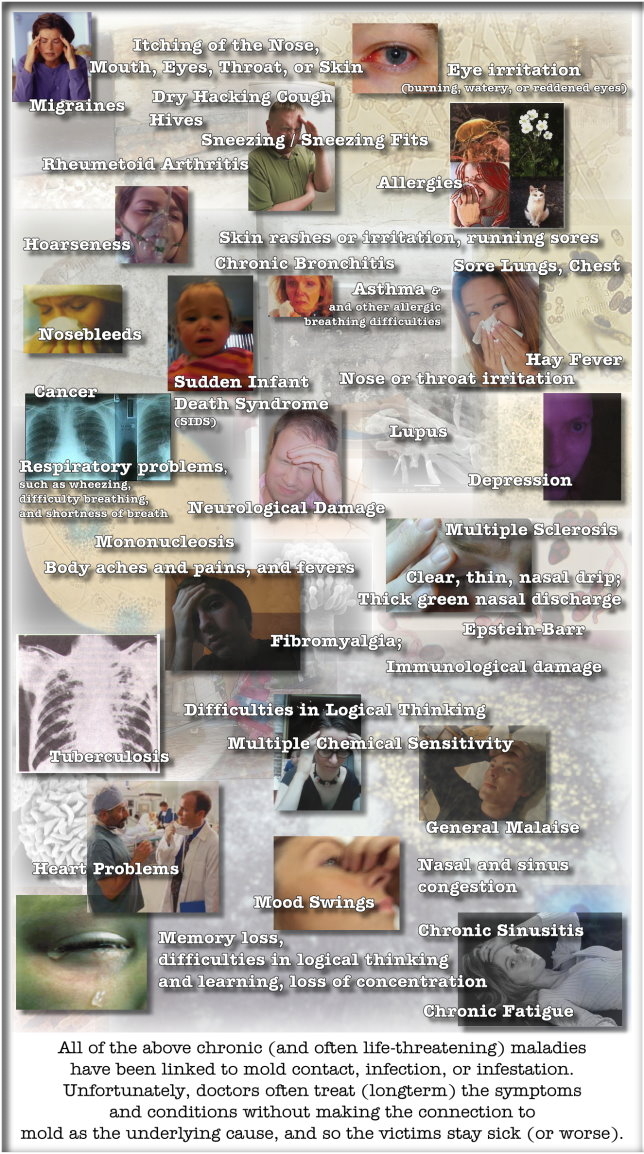
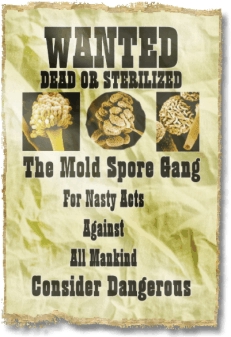
And
the lifelong pain, suffering,
and expense of a mold-exposed patient
who becomes immune compromised
is incalculable.
One
of the consequences is that lawsuits
over indoor air quality issues are being
viewed in the legal community as the
next national tidal wave of litigation,
a trend so huge that all other previous
trends (such as asbestos and tobacco)
will pale by comparison both in the
scope and number of the trials and in
the amounts of the settlements.
|
A proper IAQ strategy must treat the ever presence
of mold spores
and
the environment into which they come
with
technology so effective
that
mold outbreaks are virtually guaranteed never
to occur.
Wherever
possible, mold must be stopped before
it gets started.
|

E.
Which technology works best?
Introduction.
THAT
something needs to be done is
fairly obvious. WHY people
do what they do is evidenced
by a recent market survey response
where buyers of air filtration
/ "purification" devices or systems
indicated their reasons for acquiring
their systems.
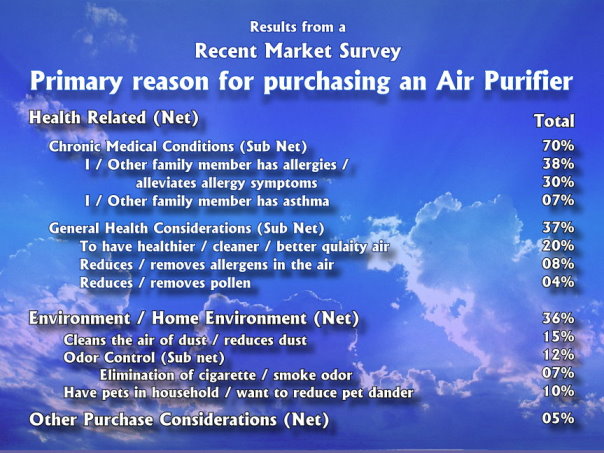
Two
QUESTIONS still remain.
1) "Are the people who
pay their money actually
getting the answers to
their concerns? And,
2) is the technology they
are acquiring doing the
job they are expecting?
As follows, they may well
be surprised at what they
are (or, really, are NOT)
getting.
Active
vs. Passive.
For all the dozens -- if not
hundreds
-- of devices offered to the
public to do some sort of
air filtering or purifying,
they all,
without exception, fall into
one of only two categories,
for there
are just two basic approaches
to IAQ issues. The most common
- because until recently the
only
approach known - has been
passive.
1. Passive
technology.
|
Passive technology always
employs some form of filtration
and always requires
that contaminates
find their way to the filtering device.
A
filter is to the airborne contaminate
what the spider's web is to the insect.
No matter how big or how
little, regardless of the size or
design, a germ or bug may fly freely
about the air space unless or until
it is caught in the trap of the filter
fibers or the web. If it is small
enough to slip through the fibers
or strong enough to wriggle loose,
it is free to fly about again. Even
if a filter were 100% effective at
trapping and keeping 100% of the contaminates
100% of the time (which it never is
or can be), its effectiveness
would be limited only to those contaminates
which physically pass through the
filtering mechanism, leaving all the
unfiltered air to remain contaminated. |

Does this represent the air "purifier"
you are depending upon? If so,
your technology is full of holes. |
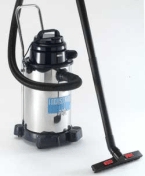
A
passive air purifier's ability to
clean a room, like a vacuum cleaner, is
limited to its physical location and
its ability to move dirt toward its
intake.
|
Another
analogy would be that of a vacuum
cleaner in a room saturated with dust
and dirt - on the floor and carpet,
the furniture, the drapes, the bookshelves,
everywhere. Giving the vacuum credit
for being 100% efficient (which it
can never be) at removing dirt from
any air that it suctions, put the
vacuum in the room anywhere you like,
high or low, and turn it on at maximum
power. Regardless of what it does
to the air and contaminates once they
enter the machine, it's ability
to clean the room is limited to its
physical location and its ability
to move dirt toward its intake.
Because of its inherent design technology,
even powered by a jet engine, it will
never clean the room completely. There
will be wind current eddies and dead
spots, just as in a running stream,
that will harbor materials which will
never see the inside of a passive
air filter. (The kind of power it
would take to get all the dirt into
the vacuum would be enough to suck
up the furnishings and carpet as well.
Plus, the noise would be unbearable!) |
|
Among
the so called air "purifier" manufacturers,
the competition is fierce. Some
do speak of "CFM"
(cubic feet
per minute), the
measured amount of air that can
pass through such a system over
a given period of time. Some companies
or models use a germicidal light
or other method to try to sanitize
or sterilize the air which makes
it through the device. At least
one make boasts an incinerator
to burn up contaminates as they
pass through. But regardless
of brand, model, size, capacity,
or features, the hottest area of
contention, however, is the efficiency
of the filter/s themselves,
often offered in multiples or multi-stages.
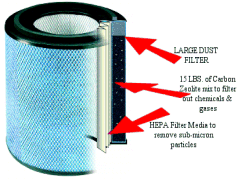 A
term often heard among air device
manufacturers is that their system
or filter meets "HEPA"
standards. A
term often heard among air device
manufacturers is that their system
or filter meets "HEPA"
standards.
Developed
after World War II to trap atomic
dust particles, "HEPA"
stands for "High Efficiency
Particulate Arrestance".
It generally means that the
filter will capture 99.97% of particulates
down to those as small as .3 microns,
which includes some bacteria, fungal,
and other opportunistic micro biologicals.
At
first glance, that is pretty impressive.
To be sure, for all those people who
have gained some measure of relief
by being able to breathe air whose
contaminates have been reduced to
some degree, HEPA and passive air
purification has been a blessing.
But the results have often
been inconsistent and not stable enough
to be accurately predictable from
one venue to another or from one piece
of equipment to the next.
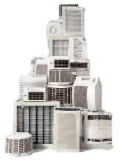 Even
among those conforming to HEPA standards
there will be discrepancies and
deficiencies depending upon when
the evaluation tests are run relative
to the buildup of the load in the
filter itself.
Was the filtering medium fresh?
Were the numbers achieved and averaged
over any particular length/s of
time and filtering loads? What were
those parameters? How dirty was
the air that went into the device?
What was the measurable air flow
at the time of the test, and how
did it compare to later when the
filter was much more full (dirtier)?
Even
among those conforming to HEPA standards
there will be discrepancies and
deficiencies depending upon when
the evaluation tests are run relative
to the buildup of the load in the
filter itself.
Was the filtering medium fresh?
Were the numbers achieved and averaged
over any particular length/s of
time and filtering loads? What were
those parameters? How dirty was
the air that went into the device?
What was the measurable air flow
at the time of the test, and how
did it compare to later when the
filter was much more full (dirtier)?
What
most have observed about other types
of filters, be they vacuum bags
or oil or air filters for cars,
is also true of HEPA filters. It
stands to reason that a filter works
by letting air pass through its
openings, whether they be small
or large (although the surrounding
fibers are an impediment). As particles
are caught on the surfaces of the
filter's fibers, they bridge over
the openings through which air is
supposed to pass and clog them.
As those openings become clogged,
the number of remaining openings
diminishes.
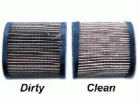 Hence,
the more that filtered particles
build up on the filtering surfaces,
the less efficient will be the flow
of air through the filter.
The slower the airstream through
a filter, the fewer the particulates
which will be taken out of the stream
flow and the less will be the efficiency
of the device. Unless a
system's rating is based upon its
minimum efficiency under
loaded conditions, any filtering
device will function at its best
when new or equipped with fresh
filtering media and drop off (often
exponentially) as it does its job
and the load increases. Hence,
the more that filtered particles
build up on the filtering surfaces,
the less efficient will be the flow
of air through the filter.
The slower the airstream through
a filter, the fewer the particulates
which will be taken out of the stream
flow and the less will be the efficiency
of the device. Unless a
system's rating is based upon its
minimum efficiency under
loaded conditions, any filtering
device will function at its best
when new or equipped with fresh
filtering media and drop off (often
exponentially) as it does its job
and the load increases.
While
diminishing filter capacity concerns
are a consideration, they do not
represent the main weakness of
passive technology. Nor is the
issue primarily the relative power
of the air moving device (fan
horsepower, speed, blade efficiencies,
etc.) The fundamental
deficiency is that the technology
is utterly dependent upon contaminates
finding their way into the filter
where they can be trapped. Experience
has shown that not all contaminates
cooperate in this effort.
And
beyond those considerations, there
may remain questions as to the viability
of pathogens and mold spores, trapped
to be sure, but which might still
be able to pose a threat where they
accumulate in the filtering device
or may find themselves scattered
when the filters are removed, replaced,
or cleaned.
|
All
of the above having been said and
factored, there is one final concern,
but it is staggering. It must be understood
that not all HEPA filters are created
equal. And it must also be acknowledged
that all HEPA filters do not perform
at the same level or efficiencies.
Some do better earlier into
their useful lives, while others may
function not as well initially but
be more consistent over their service
life. Be that as it may, as of this
time in history, the HEPA filter as
a class seems to be the best
of the best as far as filters
and filtration technologies
are concerned (all of which are passive
and, consequently, limited as discussed).
One huge fact remains, an issue having
to do with the sheer physics of the
problem.
While
the list of particles and particle
sizes flitered out by HEPA compliant
filters appears to be impressively
grand (all sizes down to .3 microns),
98.5% of all particle counts
are <.5 microns! As tiny
as these particles are individually,
their collective mass comprises
6% by weight of all the particles
in the air. If at first glance 6%
of the weight of collective particulates
may seem somewhat small, think of
the massive amount of weight and the
large particle sizes one would find
in a full vacuum container bag or
an air filter. Depending upon the
vacuum or filter type, three to six
percent (or even more) of all the
particulates one would want cleaned
from the breathing space would pass
all the way through the filter and
back out again, even if the filter
device could force all the particles
in the room to enter its orifice.
Then remember that it is the
small particulates (<.5 microns)
which make us ill. |
Passive air purification technology,
regardless of how efficient, leaves
unresolved any items or issues not
passing through its system, and,
is, therefore, an inferior and aged
approach if utilized alone.
|
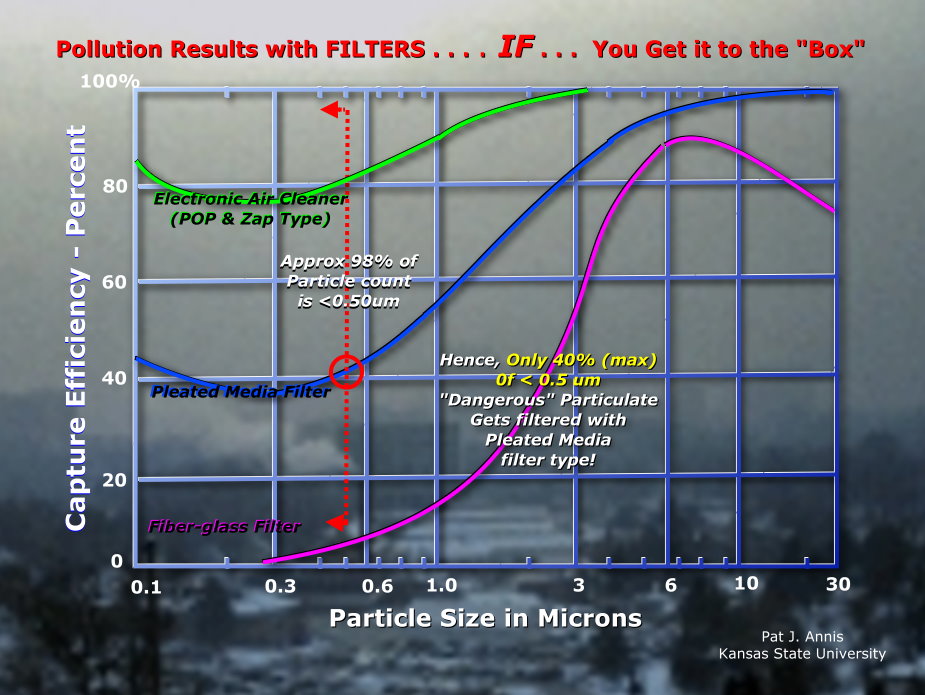 |
|
Summary
of the common problems
faced by ALL Passive Technologies |
| X |
IMPOSSIBLE
for ALL air to get TO them and THROUGH
them.
|
| X |
FILTERS
and PLATES become constant source
of POLLUTION,
HIGH
MAINTENANCE, and COST. |
| X |
FILTERS
and PLATES have LIMITED EFFECT on
VOC's, ODORS, BACTERIA, MOLD, and
MILDEW which pass through the systems. |
| X |
FILTERS
and PLATES have NO EFFECT on VOC's,
ODORS, BACTERIA, MOLD, and MILDEW
on SURFACES in the room. |
| X |
Where
UV lights are used, they affect only
the specific areas
onto
which they directly shine. |
| X |
VENTILATING
is extremely expensive and limited
in its effectiveness.
|
| X |
If
PASSIVE technology is so effective,
WHY ISN'T THE PROBLEM
SOLVED? |

Top of IAQ Overview: Table of Contents --^
<<-- Previous Chapter: IAQ Overview -- What Are We Breathing?
Beginning
of this Chapter: IAQ Overview -- Which Technology Works the Best? --^
Next Chapter: IAQ Overview --
Major Differences in Available Technologies -->

| 2. |
Active
technology. |
 |
|
As
designed for nature, there is
virtually no such thing as "passive"
air purification.
While the natural processes for
purifying water are primarily
passive, outdoor air is
purified by processes which are
expressly active. Sunlight
and lightning
and the effects of the wind rushing
through the trees (among others)
give us our purified breathable
air. The ability to do
indoors what was designed for
the outdoors lies at the heart
of active (or pro-active)
technology which does not
wait for contaminates to find
a filter.
Instead
of a "spider's web" approach which
depends upon particulates hitting
the filter media, active
air purification technology is
like launching a never ending
stream of billions of "microscopic
electric fly swatters" or "Pac
Men" which seek out and remove
from the air whatever is floating
around which would cause us respiratory
distress. It utilizes
an exclusive synergistic multi-stage
combination of scientifically
proven methods for finding and
dealing with the contaminates
wherever they are.

IAQ Overview: Table of Contents --^
<<-- Previous Chapter: IAQ Overview -- What Are We Breathing?
Beginning
of this Chapter: IAQ Overview -- Which Technology Works the Best? --^
Next Chapter: IAQ Overview --
Major Differences in Available Technologies -->

a.
Stage
One -- Dual Ionization (Particulate
Removal).
Stage
one is actually a combination
of two steps. Two separate ion
generators put out large volumes
of both positive and negative
ions and introduce them into the
entire environmental space with
very little noise. These opposingly
charged ions penetrate through
walls, attic spaces, and rooms
throughout the building, causing
air-borne particulates to flocculate
or clump together, rendering them
too heavy to remain air-borne.
|
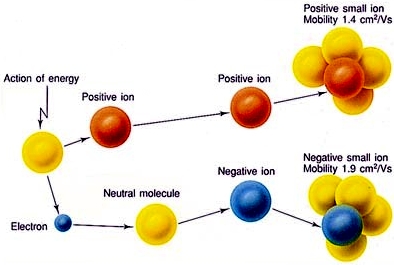 |
Although
they were once small enough to remain
airborne, electrically charged ions
have attracted enough particulates
together so that they must fall out
of breathing range. |
Like
aircraft too heavy for their engines
or jumbo jets out of fuel, the particulates
stagger and fall to the floor, colliding,
collecting, and clumping with others
on their way down. Rather
than passive,
this is active
technology
which fully sweeps and cleans the
interior air spaces and penetrates
into cavity areas. Ions also
adversely affect the health of pathogens
while improving the feeling of well
being among people and animals.
|

b.
Stage
Two -- Quad Oxidizing Plasmas.
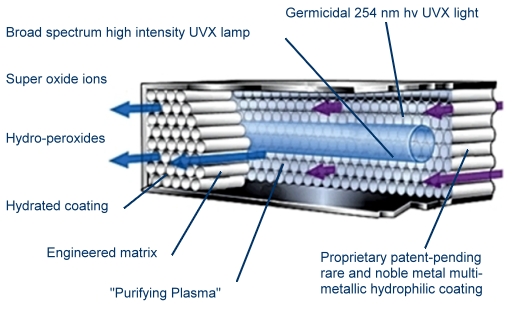
Stage
two involves the simultaneous
use of another technology which
introduces a plasma of multiple,
"friendly" oxidizers into the
living space.
(They are known as "friendly",
for, just as in nature, whether
or not they have had the opportunity
to do their assigned duties,
within about thirty minutes,
they revert right back to molecules
of H2O from whence
they were derived from the air
in the atmosphere.)
Combining high intensity UVX
light with a specially developed
rare metal hydrophilic coating
on an engineered matrix, Radiant
Catalytic Ionization™
(RCI™) reduces
airborne contaminants, and
odors while creating super
oxide ions and hydro-peroxides.
While active, these
oxidizers also have
the potential of infiltrating
behind wall cavities, and
wherever they go they strip
the very hardy shells off
of mold spores, fungi, and
numerous other pathogens and
contaminants, killing them
outright or rendering them
very susceptible to destruction.
By
engineering the proper light
wavelengths into the RCI™
cell, what develops is a highly
effective system designed to
utilize 254 nm hv germicidal
UV light. Falling between visible
UV light and invisible X-Rays
in the light spectrum, UVX
makes use of the same oxidation
and ionizing properties of light
as naturally occurring sunlight.
This technology takes advantage
of these ionizing properties
and combines them with the photo
catalytic reactions of specific
rare and noble metals to create
Radiant Catalytic Ionization™
(RCI™).
This innovative use of light
is what makes RCI™
so effective.
|


IAQ Overview: Table of Contents --^
<<-- Previous Chapter: IAQ Overview -- What Are We Breathing?
Beginning
of this Chapter: IAQ Overview -- Which Technology Works the Best? --^
Next Chapter: IAQ Overview --
Major Differences in Available Technologies -->

c.
Stage
Three -- Advanced Oxidization.
In
stage three, additional
technology generates a tunable
level of naturally occurring penetrating
oxidation gases which attack the
nuclei of the now exposed cells,
either fully killing the pathogenic
cell, or, as in the case of mold
spores, affecting the RNA and
the DNA of the spores so that
they cannot reproduce.
(While science cannot agree as
to whether such a spore is technically
"dead" or alive, there is agreement
that neutered cells cannot
proliferate and create mold or
pathogenic colonies.
Part of the problem may be that,
because 200,000 or so spores can
fit on the head of a pin, we may
not have a stethoscope small enough
to listen for a pulse on any of
them.)
d.
Combo
Effect -- The Whole is Greater
Than the Sum of its Parts.
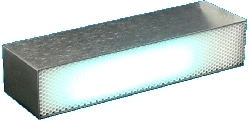
"These
are highly reactive chemical
species. Hydroxyl radicals
are very strong oxidizers
and will attack all kinds of
organic materials.”
--
Daniel
Blake, Dept of Energy’s Natural Renewable Energy
Laboratory, Golden, Colorado
As
with the ions, the generated
oxidizing plasmas are so efficient
that they penetrate to wherever
the germs are hiding and render
them harmless. This patented
triple combination of pro-active
technologies is available exclusively
under the trade name of "RCI"TM,
so named for "Radiant
Catalytic
Ionization",
also trademarked. RCITM
has been shown in university
studies to have a kill rate
as high as six log (99.9999%)
of surface laden pathogens anywhere
in the air space.
|
3.
Major
differences in Available Technologies.
It
should be rather obvious. Things that are not
the same are not equal.
On
occasion, disparate technologies may approach
a problem from different perspectives and in
different ways, coming up with similar results.
In the contest between passive and active air
purification technologies, different they are.
Similar or equal results? Nowhere close.
|
| a. Literally
out of this world. |
The science behind the RCITM
technology was originally developed for
the critical needs and challenges found
in space exploration. NASA refers to the
product of this process as "the purest
air on the planet", and it is the only
air purification technology in the entire
solar system to have won the prestigious
Certified Space TechnologyTM
designation.
Today
it is used to insure the health and safety
not only of our astronauts in the space
station, but also of our naval personnel
on America’s nuclear subs.
|

In
space, there's no second chance if you get
it
wrong, especially in the quality of the
air. |
 In
both instances, we would all agree, breathing
doesn't get a second chance if the air becomes
fouled. With RCITM
technology, it's the germs, not the people,
who don't get a second chance. Now THAT
is PRO-ACTIVE!!! In
both instances, we would all agree, breathing
doesn't get a second chance if the air becomes
fouled. With RCITM
technology, it's the germs, not the people,
who don't get a second chance. Now THAT
is PRO-ACTIVE!!! |


For
indoor air quality, active air purification
is more than just a little unique. It
is absolutely off the charts. How much
so was begun to be realized with the discovery
of an unanticipated phenomenon during
laboratory testing.
RCI'sTM
Triple-Pro-active Technology is so effective
at cleansing treated air space of particulates
that it actually created somewhat of a
problem. In all the thousands of models
of air filters and air cleaning devices
that have ever been tested, not one had
ever encountered a similar difficulty,
because no other technology had ever gotten
the air so free of particulates as the
active purification technology behind
RCITM.
Not one. Not one time.
c.
Too
Clean
to Test for Purity?
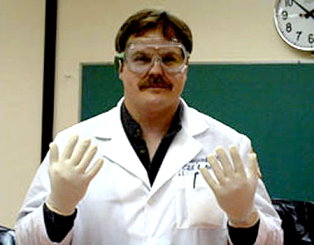
With
air quality, there are at least two major
factors —
cleanliness,
the relative freedom of particulates (dirt)
in the air and
purity,
the relative lack of germs in the air.
Historical air testing for purity requires
finding dirt (particulates) in the air
and checking the health and vitality of
the germs living on or in the dirt.
Under
standard testing protocol, if the dirt
(particulates) happen to test relatively
germ free or the germs are not very healthy,
the air is declared to be fairly pure
– even though it took the presence
of dirt in the air in order to make that
determination. Sounds a bit silly
and circular. So much for yesterday's
technology and its understanding of the
problem.
 But it gets even funnier. We have the
Best Available Today's
Technology (“BATT”)
which efficiently removes the dirt (particulates)
from the air so that there is nothing
in the air to capture on which to measure
the health and vitality of germs. Yesterday's
science says, “Since we can't find
any dirt to check for germs (it’s
too CLEAN), we cannot certify how pure
(germ free) your air is.”
But it gets even funnier. We have the
Best Available Today's
Technology (“BATT”)
which efficiently removes the dirt (particulates)
from the air so that there is nothing
in the air to capture on which to measure
the health and vitality of germs. Yesterday's
science says, “Since we can't find
any dirt to check for germs (it’s
too CLEAN), we cannot certify how pure
(germ free) your air is.”
Put
another way, it sounds like this. “The
air has to be sufficiently dirty in order
to find enough dirt in the air in order
to measure the germs on the dirt in order
to certify how relatively pure the less
than clean dirty air is.” And so
far, in the absence of any dirt to give
them something to test, no private or
governmental agency has been successful
in designing a protocol to test the actual
purity of RCI'sTM
treated un-particulate-laden air.
|
| e.
What
to do? |

What
to do? What to do? |
Reason
would dictate that in the absence
of particulates, any viable pathogens
are left without a transport mechanism
by which to enter our private air spaces.
That has to be a positive factor in the
overall indoor air quality.
But
is it enough? Knowing that we can't test
the “purity” of the air by
means of the old methods and definitions,
we set out to test the effectiveness of
the technology itself.
Left
with no other alternatives, what we can
do and have done at this point is to smear
live cultures of some really nasty germs
on stainless steel surfaces in a laboratory,
turn on our equipment, and see if any
of the culture colonies survive what RCITM
does to germs. While the test itself
may be a bit unconventional, the results
are mouth-droppingly compelling.
|


First
off, we went after some pretty infamous
bacteria -- fellas like Staphylococcus
aureus, MRSA (the antibiotic resistant
strain of Staphylococcus aureus that is
wreaking havoc in our hospitals), E.
coli, Bacillus
spp., streptococcus
spp., Listeria
monocytogenes, Stachybotrys
chartarum (black mold), etc., mean
guys with ugly names and bad reputations.
Within surprisingly short periods of time,
kill rates on the pathogen samples were
averaging well above 99% and some spiked
as high as 100%. The response of the test
team was so positive over those results
that the technology was later tested against
some equally challenging viruses as well.
Kill rates were similar, even against
tested strains of hepititis and the dreaded
Avian flu (100% killed)!
All that can be officially extrapolated
at this point is that, if pathogens are
being killed wherever they may be hiding
on horizontal or vertical surfaces, there
will be a virtual absence of pathogens
in or out of the air within any airspace
or wall cavity where this RCITM
Five-way Technology has been employed.
So, the assumption is logically made,
and the anecdotal evidence seems to support
the fact, that the air must be mighty
fresh and pure since we are not breathing
dirt, and germs can't live or grow in
our RCITM
purified air. Click
here to see the same results which amazed
us!
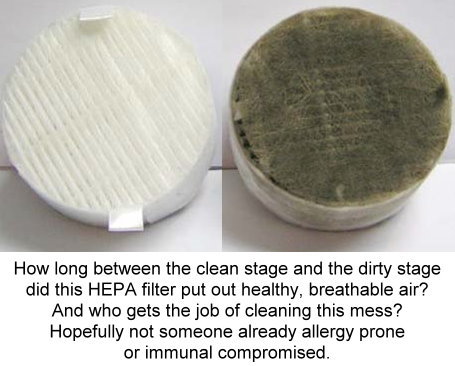 In
laboratory as well as practical terms,
there is a HUGE difference between a kill
rate of 99 to 100% with
RCITM
and the maximum HEPA figures — as
respectable as they seem to be —
of 99.97% of filtration
of particles larger than a certain
size which happen to pass through the
filtering device.
RCI'sTM
active technology is going after
unwanted bacteria, viruses, spores, and
germs – even if they are nowhere
near the air purifier – and destroying
them where they rest as well as where
they hide. In
laboratory as well as practical terms,
there is a HUGE difference between a kill
rate of 99 to 100% with
RCITM
and the maximum HEPA figures — as
respectable as they seem to be —
of 99.97% of filtration
of particles larger than a certain
size which happen to pass through the
filtering device.
RCI'sTM
active technology is going after
unwanted bacteria, viruses, spores, and
germs – even if they are nowhere
near the air purifier – and destroying
them where they rest as well as where
they hide.
There
is no chance for a mistake, spill, or
reinfection from a collection of pathogens
in a filter which must then be properly
handled and disposed.
h.
Odor
Abatement/Removal.
 The
same thing that RCITM
does to particulates and germs it does
also to smoke, dust, and
sources of odors. The
same thing that RCITM
does to particulates and germs it does
also to smoke, dust, and
sources of odors. Once
oxidized by RCITM,
an odor source is no longer in decay and
is therefore rendered neutral, harmless,
and odor free – without toxic sprays
and ineffective (and possibly hazardous)
deodorant cover ups. Likewise, RCITM
goes to work on the chemical offgassings
of VOC's, which are also neutralized and
rendered harmless. Where smoke,
animal odors, decomposition odors, body
odors, garbage odors, etc., rendered an
air space uncomfortable or uninhabitable,
Active Purification TechnologyTM
seeks out the offending sources of those
odors, and its full sanitization can restore
the indoor air quality to a fresh, clean,
pleasant condition while SurfaceGuardTM
Technology makes it safe again, killing
the odor-causing germs on the surfaces
inside the space.
|

F.
What
IAQ issues must be considered and addressed?
 Before
acquiring any type of air purifier or installing
any kind of whole house or whole building system,
it might be best to consider what the expected
outcome should be and compare it with the capacities
of the devices or systems to achieve those goals.
Before
acquiring any type of air purifier or installing
any kind of whole house or whole building system,
it might be best to consider what the expected
outcome should be and compare it with the capacities
of the devices or systems to achieve those goals.
| Effectiveness
Comparison Chart |
—
Scores as follows —
"N" = "No" --- "L" = "Limited" --- "Y" =
"Yes" |
Passive
Technology
|
|
RCITM
ACTIVE Purification Technology
|
| L |
Particulate
Control/Reduction
|
Y |
Particulate
Control/Reduction
|
| L |
Dust
Control/Reduction
|
Y |
Dust
Control/Reduction
|
| N |
Reducing/
Removal of Dust/Dander/Skin Mites |
Y |
Reducing/
Removal of Dust/Dander/Skin Mites |
| L |
Smoke
Control/Reduction
|
Y |
Smoke
Control/Reduction
|
| N |
Odor
Reduction/Elimination
|
Y |
Odor
Reduction/Elimination
|
| N |
Mold
Sanitization
|
Y |
Mold
Sanitization
|
| N |
Inhibition/Prevention
of Mold Colony Formation or Mold Regrowth
by Neutering of Mold Spores |
Y |
Inhibition/Prevention
of Mold Colony Formation or Mold Regrowth
by Neutering of Mold Spores |
| N |
Bacteria
Control/Reduction
|
Y |
Bacteria
Control/Reduction
|
| N |
Pathogenic
Control/Reduction
|
Y |
Pathogenic
Control/Reduction
|
| N |
Control/Reduction/Neutralizing
of V.O.C's
|
Y |
Control/Reduction/Neutralizing
of V.O.C's |
| N-L |
F.O.G.
(Fat, Oil, and Grease) Control/Reduction |
Y |
F.O.G.
(Fat, Oil, and Grease) Control/Reduction |
| N |
Discouragement/Elimination
of Vermin/Insects |
Y |
Discouragement/Elimination
of Vermin/Insects |
| L |
Improvement
of Overall Air Quality
|
Y |
Improvement
of Overall Air Quality
|
| N |
Certified
Space TechnologyTM
|
Y |
Certified
Space TechnologyTM
|
Add
up the scorecards and decide
which
is the superior approach to indoor air quality
issues. |
| ___ |
Total
Y’s (Yes’s) |
|
___ |
Total
Y’s (Yes’s) |
| ___ |
Total
L’s (Limited’s) |
|
___ |
Total
L’s (Limited’s) |
| ___ |
Total
N’s (No’s) |
|
___ |
Total
N’s (No’s) |
|
|
|
|
|

G.
Are
there medical considerations?

1.
Obligatory
disclaimers.
a.
None
of the items Pro-active Environmental Technologies
recommends and
installs are currently rated as or to be considered
as medical devices in the legal
understanding and use of the term.
Therefore, no medical claims are made for
the use or the failure to use any of the offered
equipment.
(Stay
tuned, though, as we are anticipating some
exciting news in this regard in the very near
future.)
b.
Neither Pro-active
Environmental Technologies nor any
of its suppliers diagnose or recommend treatment
for any illness or disease. There are hosts
of alphabet soup type regulatory bodies with
which to deal in the medical arena, and we find
our time and energies better used in other endeavors
than responding to their onerous paperwork.
c. Information
made available here directly or indirectly is
tendered so that informed parties can make informed
decisions.
2.
Practical
realities.
However,
with the above’s being said, there are
some aspects to consider which may have some
"medical" or health implications in the broadest
applications and understandings of the terms.
There are millions of people living in situations
where indoor air quality has compromised their
bodies' immune systems, has allowed them to
become allergic, infected, and sick, and whose
lives and lifestyles are far less than optimal
as a result.
|

A
child with Burkitt's lymphoma, a type
of tumor first discovered in Africa. The
African form of Burkitt's lymphoma is
often associated with early childhood
infection by the Epstein-Barr virus.
Custom Medical Stock
Photo, Inc.
|
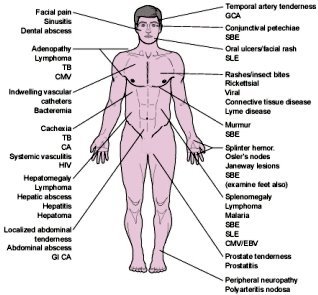
Epstein-Barr
Symptoms –
Epstein-Barr
Syndrome is often brought on by
exposure
to mold
and
a resulting weakened immune system. |
Straight common sense would dictate that
any effective means by which pollutants,
particulates, contaminants, pathogens, allergens,
irritants, offensive odors, VOC's, dust
and dust mites, mold and mold related problems,
and other indoor air quality concerns are
seriously reduced or eliminated will have
a profoundly positive effect on anyone's
health.
|
Imagine
being so blessed as to be breathing truly purified
air as a result of the presence and utilization
of these wonderful and exclusive technologies
where the body can concentrate on strengthening
and healing instead of constant and preventable
"housecleaning" chores!
Would
living in such a pleasantly sanitary atmosphere
heighten the risk of infection outside of such
an improved environment? To the contrary, it seems
only logical that allowing the immune system to
balance out and rebuild itself free from the onslaught
of polluted indoor air should potentially strengthen
one's resistance to infections when out in public.
- We
can point to the results from sophisticated
and structured tests showing what happens to
pathogens and contaminants when exposed to our
technologies.
- We
can conduct onsite testing proving the efficacy
of our technology in your living or working
environment.
- We
can cite testimonials from those who claim that
their lives and health have been greatly improved
by utilizing our products and services.
But
only you
can decide what is best for you, your family,
and the air spaces over which you choose to take
responsibility and take control,
for that choice is yours and yours alone to make.
|
|
If the pollutants our technology is designed
to reduce or eliminate are making you or
your loved ones sick, or even have the potential
of doing so, it only makes sense that life
with those pollutants reduced or removed
will be healthier and happier. |
|
H.
Are there legal and other considerations?
Applications
of these technologies have practical, economical,
and legal implications. Having these systems in
place will help insure against mold infestations
so prevalent in the Gulf Coast climate and elsewhere.
By all but eliminating any particulates, the indoor breathing
space will not create a burden on the environs,
and housekeeping will be much more easily accomplished
and maintained. The oxidizing process neutralizes,
abates, and eliminates most or all odors, including
VOC's. By oxidizing pollen, mold spores, viruses,
bacteria, microbes,
and the like the living space or workplace will
be much friendlier.
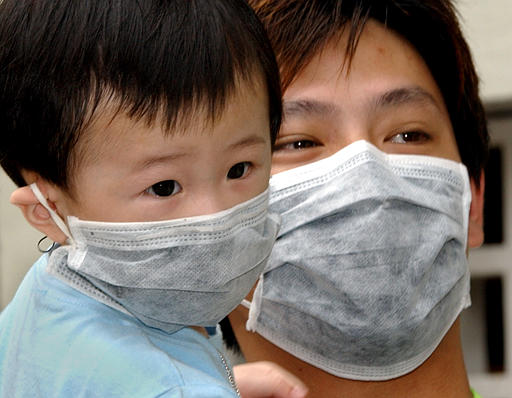 And
it will be safer. (This
is the same American technology the government
of China acquired to combat
SARS. Even sneezes, which are expelled
at 300 mph, are clinically proven to have 78%
of their pathogens killed within three feet.)
The SurfaceGuardTM
Technology renders the surfaces sanitary,
killing the countless hidden germs, pathogens,
microbes, and mold spores better, faster, and
more thoroughly than by any other safe method.
The air is fresher, cleaner, purer, and much more
enjoyable. And
it will be safer. (This
is the same American technology the government
of China acquired to combat
SARS. Even sneezes, which are expelled
at 300 mph, are clinically proven to have 78%
of their pathogens killed within three feet.)
The SurfaceGuardTM
Technology renders the surfaces sanitary,
killing the countless hidden germs, pathogens,
microbes, and mold spores better, faster, and
more thoroughly than by any other safe method.
The air is fresher, cleaner, purer, and much more
enjoyable.
The
effect is a far healthier indoor environment.
A properly air purified workplace contributes
to a more robust and attendant employee roster.
It also guards against Sick Building Syndrome
by reducing and eliminating the causes of same
before they become pandemic. This translates into
dollars because of lowered absenteeism and generally
better output. The sanitized environment of a
correctly air purified home lends itself to healthier,
less stressed living. Sleep is enhanced because
dust mites and their attendant problems become
things of the past. Allergy and asthma sufferers
testify to finding welcome relief as their respiratory
loads are dramatically reduced.
Individual
pieces within a Pro-active Environmental
Technologies protected air purified environment
- as well as the system in its entirety - comprise
a combination of patented technologies which are
considered the Best Available Today's
Technology ("BATT").
That's peace of mind on a personal level that
you are doing all that is possible for yourself
and your loved ones in providing pure indoor air.
Using
a BATT approach to your office
or workplace IAQ needs, whether in an industrial,
commercial, institutional, or hospitality setting
dramatically lightens the concerns over liability
and litigation actions having to do with IAQ issues.
This means for the properly prepared client that,
should an IAQ legal problem arise, for any building
where these technologies are installed and utilized,
there can be no finding of culpability or liability
for ignorance or neglect (and hence, no settlement
amount), in that the technologies employed represent
the best attempt/s humanly possible to address
IAQ problems. Period.

|
I.
When is Timing an Issue?
As
an environmental consideration, the sooner proper
air purification equipment is installed, the less of a build-up of indoor air contaminates will
contribute to the overall health hazards of the
occupants. If construction is old, mold colonies
could already be forming in out of sight places
while contributing to the declining air quality.
Levels of dangerous toxic substances could already
be
reaching critical levels, and the sooner all negative
contributors are neutralized, the better for all
(except, perhaps, the lawyers).
of a build-up of indoor air contaminates will
contribute to the overall health hazards of the
occupants. If construction is old, mold colonies
could already be forming in out of sight places
while contributing to the declining air quality.
Levels of dangerous toxic substances could already
be
reaching critical levels, and the sooner all negative
contributors are neutralized, the better for all
(except, perhaps, the lawyers).
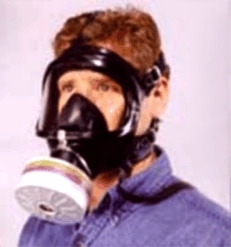 If
the buildig is relatively new, VOC's, unless oxidized,
will continue to accumulate as carpet, carpet
underlayment, wall coverings, adhesives, paneling,
laminates, furnishings, electronic equipment,
treated fabrics, and other items are installed,
moved in, or used. Further, the fact that construction
may be new is no guarantee that mold spores have
not taken residence or even already started forming
colonies, especially where cinder block or wood
might have been exposed to rain during the erection
phase. The sooner that the Five-way Active Purification
Technology provided by RCI™ is in place,
the less likely it will be for mold to become
an issue. If
the buildig is relatively new, VOC's, unless oxidized,
will continue to accumulate as carpet, carpet
underlayment, wall coverings, adhesives, paneling,
laminates, furnishings, electronic equipment,
treated fabrics, and other items are installed,
moved in, or used. Further, the fact that construction
may be new is no guarantee that mold spores have
not taken residence or even already started forming
colonies, especially where cinder block or wood
might have been exposed to rain during the erection
phase. The sooner that the Five-way Active Purification
Technology provided by RCI™ is in place,
the less likely it will be for mold to become
an issue.
Fortunately,
the facts favor our ability to "Take Responsibility,
Take Control" of our own environments. It
is neither the job of government nor of charities
to do for us what we can do for ourselves. The
exciting news is found in the technologies we
now have available to make a positive difference
for ourselves, our loved ones, and our posterity.
Read on and be encouraged and amazed!
|




Copyright
2005 - 2014 -- breathe-easier.com
-- All Rights Reserved
|
 |
|
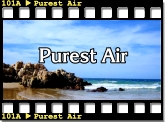



































 From
our first breath until our last – and all those wonderful breaths
in between,
From
our first breath until our last – and all those wonderful breaths
in between, 
































 t likely take for
granted
t likely take for
granted The
fact is, that with every breath we take, we are also taking into our
lungs and bodies any number of other things, including gasses (many of
which we cannot smell so that we are unaware of their presence or
harm), odors (which are molecular samples of the things causing the
smell), fats, oils, and grease, and varying amounts of tiny pieces of
solid materials we often refer to as "dust" - which may be comprised of
all manner of things from metallic, to mineral, to chemical, to organic.
The
fact is, that with every breath we take, we are also taking into our
lungs and bodies any number of other things, including gasses (many of
which we cannot smell so that we are unaware of their presence or
harm), odors (which are molecular samples of the things causing the
smell), fats, oils, and grease, and varying amounts of tiny pieces of
solid materials we often refer to as "dust" - which may be comprised of
all manner of things from metallic, to mineral, to chemical, to organic. While
Americans annually spend some $3 billion to cover up smells they find
offensive, reality dictates that serious air purification must look
beyond room fresheners and scented candles and get to the source of
our indoor air quality concerns.
While
Americans annually spend some $3 billion to cover up smells they find
offensive, reality dictates that serious air purification must look
beyond room fresheners and scented candles and get to the source of
our indoor air quality concerns.






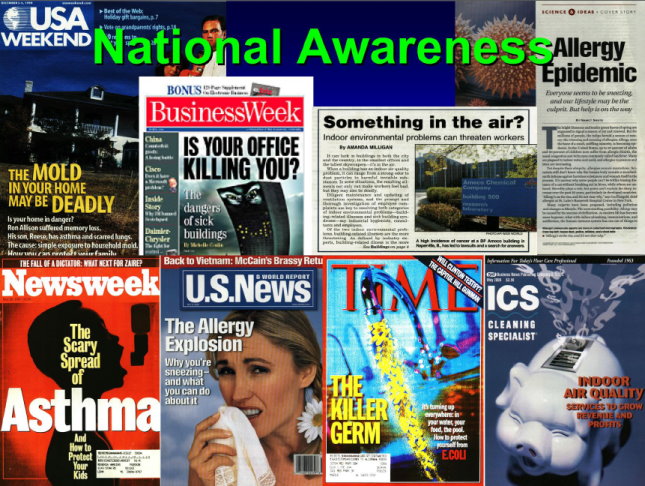
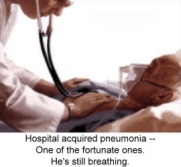

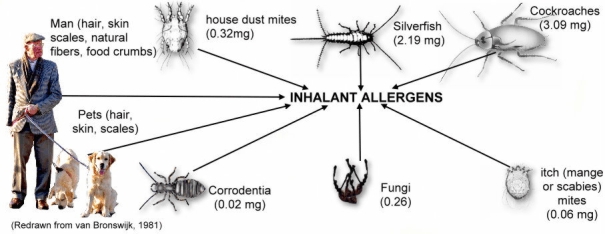

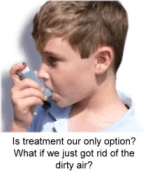
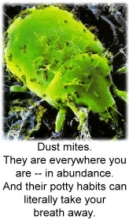




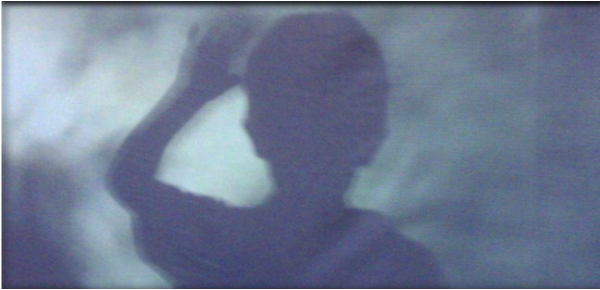




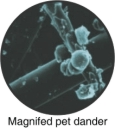
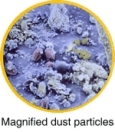
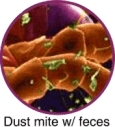
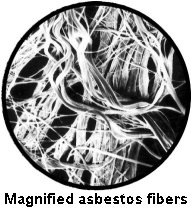
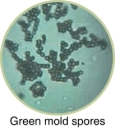
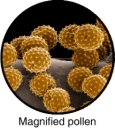
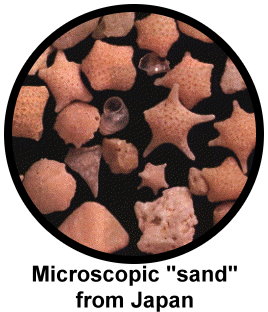
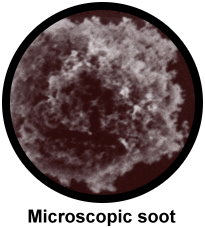
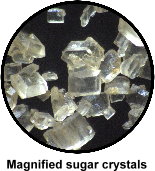
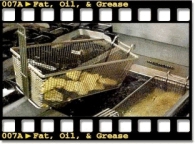
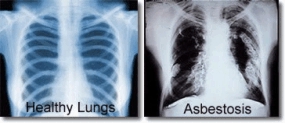
 exposures to a growing number of these
particulates are becoming more frequent
and cumulative, and with less than ideal
recovery conditions, less than optimum
nutrition, and a general lack of good,
breathable air, we are increasingly falling
victim to their ravages.
exposures to a growing number of these
particulates are becoming more frequent
and cumulative, and with less than ideal
recovery conditions, less than optimum
nutrition, and a general lack of good,
breathable air, we are increasingly falling
victim to their ravages. 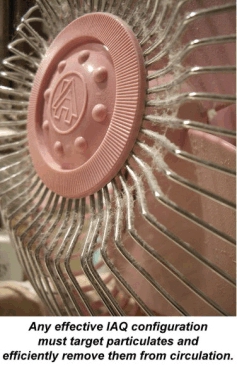

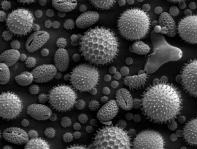

 The
most obvious one is the body's reaction
to a specific irritant whose presence
has escalated the immunal response to that
of an allergic reaction.
The
most obvious one is the body's reaction
to a specific irritant whose presence
has escalated the immunal response to that
of an allergic reaction.

 It
was millennia before civilization relearned
what the ancients knew about the effects
of washing in running water to help reduce
infection. However, even when proper hygiene
is practiced, we still get sick from germs
which make their ways into our bodies. How
is that possible? If we are not ingesting
them through our mouths or they are not
insinuating themselves into our systems
by bodily contact, how is it we are still
getting sick?
It
was millennia before civilization relearned
what the ancients knew about the effects
of washing in running water to help reduce
infection. However, even when proper hygiene
is practiced, we still get sick from germs
which make their ways into our bodies. How
is that possible? If we are not ingesting
them through our mouths or they are not
insinuating themselves into our systems
by bodily contact, how is it we are still
getting sick?


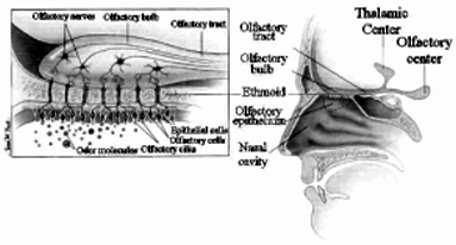
 the
surface - where they tend to break
free of the chemical bonds which hold
them together and take flight into
the surrounding air. This phenomenon
is called "off-gassing", and the measure
of the rate at which
it occurs is the measure of its "volatility".
Depending upon the nature of the substance
itself, the product of the off-gassing
will be either benign or toxic. (See
"VOC's" next.)
the
surface - where they tend to break
free of the chemical bonds which hold
them together and take flight into
the surrounding air. This phenomenon
is called "off-gassing", and the measure
of the rate at which
it occurs is the measure of its "volatility".
Depending upon the nature of the substance
itself, the product of the off-gassing
will be either benign or toxic. (See
"VOC's" next.)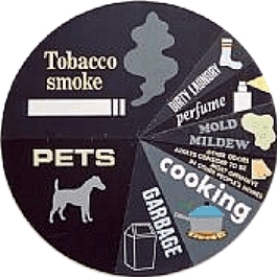


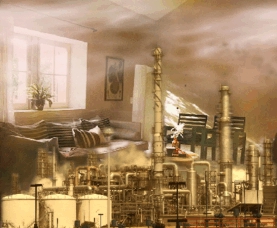


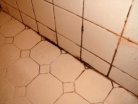

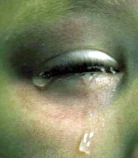






 A
term often heard among air device
manufacturers is that their system
or filter meets "HEPA"
standards.
A
term often heard among air device
manufacturers is that their system
or filter meets "HEPA"
standards. 
 Hence,
the more that filtered particles
build up on the filtering surfaces,
the less efficient will be the flow
of air through the filter.
The slower the airstream through
a filter, the fewer the particulates
which will be taken out of the stream
flow and the less will be the efficiency
of the device. Unless a
system's rating is based upon its
minimum efficiency under
loaded conditions, any filtering
device will function at its best
when new or equipped with fresh
filtering media and drop off (often
exponentially) as it does its job
and the load increases.
Hence,
the more that filtered particles
build up on the filtering surfaces,
the less efficient will be the flow
of air through the filter.
The slower the airstream through
a filter, the fewer the particulates
which will be taken out of the stream
flow and the less will be the efficiency
of the device. Unless a
system's rating is based upon its
minimum efficiency under
loaded conditions, any filtering
device will function at its best
when new or equipped with fresh
filtering media and drop off (often
exponentially) as it does its job
and the load increases.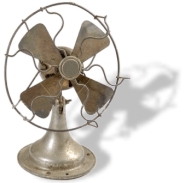





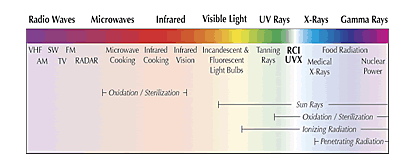



 In
both instances, we would all agree, breathing
doesn't get a second chance if the air becomes
fouled. With RCITM
technology, it's the germs, not the people,
who don't get a second chance. Now THAT
is PRO-ACTIVE!!!
In
both instances, we would all agree, breathing
doesn't get a second chance if the air becomes
fouled. With RCITM
technology, it's the germs, not the people,
who don't get a second chance. Now THAT
is PRO-ACTIVE!!! But it gets even funnier. We have the
Best Available Today's
Technology (“BATT”)
which efficiently removes the dirt (particulates)
from the air so that there is nothing
in the air to capture on which to measure
the health and vitality of germs. Yesterday's
science says, “Since we can't find
any dirt to check for germs (it’s
too CLEAN), we cannot certify how pure
(germ free) your air is.”
But it gets even funnier. We have the
Best Available Today's
Technology (“BATT”)
which efficiently removes the dirt (particulates)
from the air so that there is nothing
in the air to capture on which to measure
the health and vitality of germs. Yesterday's
science says, “Since we can't find
any dirt to check for germs (it’s
too CLEAN), we cannot certify how pure
(germ free) your air is.” In
laboratory as well as practical terms,
there is a HUGE difference between a kill
rate of 99 to 100% with
RCITM
and the maximum HEPA figures — as
respectable as they seem to be —
of 99.97% of filtration
of particles larger than a certain
size which happen to pass through the
filtering device.
In
laboratory as well as practical terms,
there is a HUGE difference between a kill
rate of 99 to 100% with
RCITM
and the maximum HEPA figures — as
respectable as they seem to be —
of 99.97% of filtration
of particles larger than a certain
size which happen to pass through the
filtering device.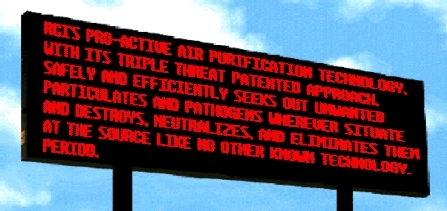










 If
the buildig is relatively new, VOC's, unless oxidized,
will continue to accumulate as carpet, carpet
underlayment, wall coverings, adhesives, paneling,
laminates, furnishings, electronic equipment,
treated fabrics, and other items are installed,
moved in, or used. Further, the fact that construction
may be new is no guarantee that mold spores have
not taken residence or even already started forming
colonies, especially where cinder block or wood
might have been exposed to rain during the erection
phase. The sooner that the Five-way Active Purification
Technology provided by RCI™ is in place,
the less likely it will be for mold to become
an issue.
If
the buildig is relatively new, VOC's, unless oxidized,
will continue to accumulate as carpet, carpet
underlayment, wall coverings, adhesives, paneling,
laminates, furnishings, electronic equipment,
treated fabrics, and other items are installed,
moved in, or used. Further, the fact that construction
may be new is no guarantee that mold spores have
not taken residence or even already started forming
colonies, especially where cinder block or wood
might have been exposed to rain during the erection
phase. The sooner that the Five-way Active Purification
Technology provided by RCI™ is in place,
the less likely it will be for mold to become
an issue.

